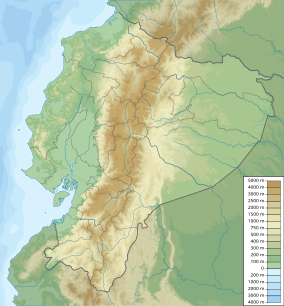| Sangay National Park | |
|---|---|
| Parque nacional Sangay | |
| IUCN category II (national park) | |
 Sangay National Park Sangay National Park | |
 | |
| Location | Ecuador |
| Coordinates | 1°50′S 78°20′W / 1.833°S 78.333°W / -1.833; -78.333 |
| Area | 5,177.65 km (1,999.10 sq mi) |
| Established | 1979 |
| UNESCO World Heritage Site | |
| Type | Natural |
| Criteria | vii, viii, ix, x |
| Designated | 1983 (7th session) |
| Reference no. | 260 |
| Region | Latin America and the Caribbean |
| Endangered | 1992–2005 |
Sangay National Park (Spanish: Parque Nacional Sangay) is a national park located in the Morona-Santiago, Chimborazo, Tungurahua, Cañar, and Azuay provinces of Ecuador. The park contains two active volcanoes (Tungurahua and Sangay), one extinct volcano El Altar (Kapak Urku). Protecting a range of elevations from 900 to 5,319 meters (2,953 to 17,451 ft) above sea level, Sangay National Park contains a wide variety of habitats, including glaciers, volcanic landscapes, tropical rainforests, cloud forests, wetlands, grasslands, and one of the largest regions of páramo (high elevation moorlands) in Ecuador. 327 lakes feed into a vast wetland system covering 31.5 square kilometers (12.2 sq mi).
Because of its complex ecology and geology, as well as its outstanding biodiversity, the park has been listed as a UNESCO World Heritage Site since 1983. In 1992, it was added to the List of World Heritage in Danger due to illegal poaching, extensive grazing, unplanned road construction, and encroachment of the park's perimeter. It was removed from the UNESCO list of endangered sites in 2005.
Etymology
The word "sangay" comes from the Shuar language word samkay, or "volcano."
Biodiversity
Due to the variety of habitats found within the park, the fertile volcanic soil, and the relatively unaltered landscape, Sangay National Park preserves an exceptional number of native species. Over 3,000 flowering plant species have been documented within the park, in addition to more than 430 bird, 107 mammal, 33 amphibian, 14 reptile, and 17 fish species.
The National Park is an important refuge for rare species of the Andes, like the mountain tapir and spectacled bear. The park is a vital stronghold for the endangered mountain tapir in particular. In the forests below live spectacled bears, giant otter, jaguar, ocelot, margay, Brazilian tapir, white-tailed deer (Odocoileus virginianus ustus), little red brocket deer and Northern pudu. The cougar and pampas cat have been recorded in the park as well. Caenolestes sangay, a species of shrew opossum, was originally described in 2013 from specimens collected from Sangay National Park.
Over 400 bird species inhabit the Park, and it has been recognised as an Important Bird Area (IBA) by BirdLife International. Notable bird species resident to the park include the Andean Condor and Andean Cock-of-the-rock.
In 2016, a new frog species in the genus Pristimantis (Pristimantis tinguichaca) was described from the park's cloud forest.
Gallery
See also
References
- ^ "Sangay National Park". UNESCO World Heritage Centre. United Nations Educational, Scientific, and Cultural Organization. Retrieved 5 September 2021.
- Julio César Carrión (27 February 2022). "Osteocephalus sangay". AmphibiaWeb (in Spanish). University of California, Berkeley. Retrieved 24 July 2022.
- Downer, CC. (1996). "The mountain tapir, endangered 'flagship' species of the high Andes". Oryx. 30 (1): 45–58. doi:10.1017/s0030605300021384.
- Nowell, K.; Jackson, P. (1996). Wild Cats: Status Survey and Conservation Action Plan (PDF). Gland, Switzerland: IUCN.
- Ojala-Barbour, R.; Pinto, C.M.; Brito, J.; Albuja, L.; Lee, T.E.; Patterson, B.D. (2013). "A new species of shrew-opossum (Paucituberculata: Caenolestidae) with a phylogeny of extant caenolestids". Journal of Mammalogy. 94 (5): 967–982. doi:10.1644/13-MAMM-A-018.1.
- UNEP & WCMC: SANGAY NATIONAL PARK ECUADOR, (letztes update 2005) PDF
- "Sangay National Park". BirdLife Data Zone. BirdLife International. 2021. Retrieved 21 January 2021.
- Brito M, J.; Ojala-Barbour, R.; Batallas R, D.; Almendáriz C, A. (2016). "A New Species of Pristimantis (Amphibia: Strabomantidae) from the Cloud Forest of Sangay National Park, Ecuador". Journal of Herpetology. 50 (2): 337–344. doi:10.1670/13-103. S2CID 55346001.
External links
- http://logronoturismo.com/
- Sangay National Park on UNESCO World Heritage Centre
- Jean-Claude Petit Butterflies of Sangay National Park
- Spectacled Bear Research and Conservation Project in Sangay National Park by Fundación Cordillera Tropical
| Protected areas of Ecuador | |
|---|---|
| National Parks | |
| Biological Reserves | |
| Ecological Reserves | |
| Geobotanical Reserves | |
| Wildlife Reserves | |
| Wildlife Refuges | |
| National Recreational Parks | |
| Binational Parks | |
| Marine Reserves | |
- IUCN Category II
- National parks of Ecuador
- World Heritage Sites in Ecuador
- Protected areas established in 1979
- Geography of Chimborazo Province
- Geography of Tungurahua Province
- Geography of Morona-Santiago Province
- Tourist attractions in Chimborazo Province
- Tourist attractions in Tungurahua Province
- Tourist attractions in Morona-Santiago Province
- World Heritage Sites in Danger
- Important Bird Areas of Ecuador
- Northwestern Andean montane forests


